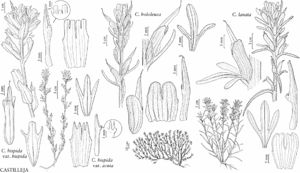Castilleja hololeuca
W. Amer. Sci. 3: 3. 1886. (as Castilleia)
Shrubs or subshrubs, 3–10 dm; from a woody caudex; with thick, woody roots. Stems many, erect to spreading, much-branched with many short axillary shoots, proximal stems reaching 1+ cm wide, white-felted, hairs dense, spreading to ± appressed, intertwined, long, soft, slightly branched, obscuring surface. Leaves ash gray, leaves of previous year persisting on proximal stem, linear, older leaves sometimes broadly linear, 1–5 cm, not fleshy, margins plane, involute, 0-lobed, apex obtuse; lobes ascending, linear-lanceolate, apex obtuse to rounded, sometimes acute. Inflorescences 3–16 × 2–4 cm; bracts pale gray-green throughout, or proximally pale gray-green, distally red or yellow, proximal linear, distal broader, often oblanceolate to obovate, (0–)3-lobed; lobes spreading, linear to oblong, short to long, arising below mid length, apex rounded to truncate or acute. Calyces colored as bracts, with conspicuous whitish veins, 14–18(–20) mm; abaxial and adaxial clefts 5–12 mm, 30–67% of calyx length, deeper than laterals, lateral 0 mm or nearly so, ca. 0% of calyx length; lobes linear-lanceolate, apex rounded, truncate, or emarginate. Corollas slightly curved in proximal 1/3, 14–26(–31) mm; tube 9–17 mm; abaxial lip not exserted, beak exserted; beak adaxially green to yellowish, 11–14 mm; abaxial lip ascending, deep green, reduced, 2–3 mm, less than 33% as long as beak; teeth reduced to apiculations, deep green, 1–1.5 mm.
Phenology: Flowering Mar–Oct.
Habitat: Coastal sage scrub, chaparral slopes and flats, ledges, forest edges.
Elevation: 0–500 m.
Distribution
Calif.
Discussion
Castilleja hololeuca is endemic to the four major islands of the northern Channel Islands. It is similar to C. lanata, a mostly Mexican species that reaches Arizona, New Mexico, and southwest Texas. However, C. hololeuca appears to be more closely related to C. foliolosa, a species of the California mainland. These three species, and C. galehintoniae G. L. Nesom of Nuevo León, all share a distinctive, thick indument of pale, matted, and often branched hairs on the stems and leaves. Large individuals of C. hololeuca form thick, woody trunks. On Anacapa Island, closest to the mainland, red-flowered forms of C. hololeuca predominate. On Santa Cruz Island, to the west, both red- and yellow-bracted forms are fairly common, usually in separate populations. Further offshore, on San Miguel and Santa Rosa islands, most plants are yellow to, occasionally, peach in coloration. Reports of this species from Santa Barbara and Santa Catalina Islands are referable to other species, mostly C. foliolosa. Populations of C. hololeuca historically declined from grazing by introduced game and livestock species. The plants are recovering well, following removal of the grazing animals, and are now common in many areas, especially on San Miguel Island.
Selected References
None.
